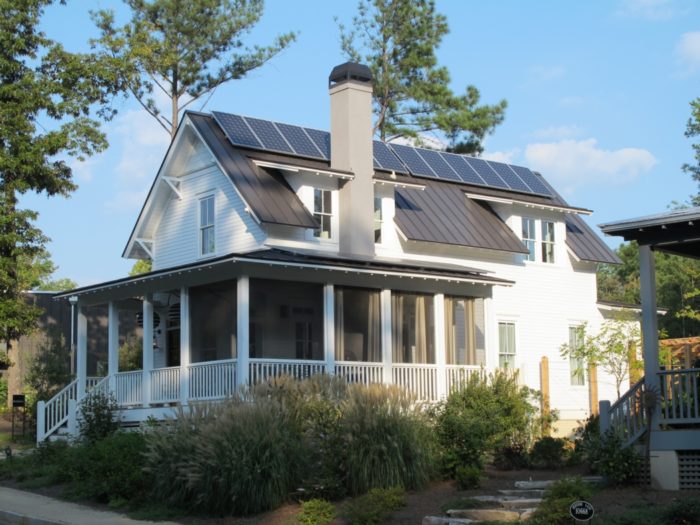
Image Credit: Alex Wilson
Image Credit: Alex Wilson One sees quite a few PV modules when walking around Serenbe. The Proud Green Home at Serenbe. The 1,400 square-foot Next Home, shown here from the rear, is priced significantly less than most homes in Serenbe. Double-stud construction will help this house achieve very good energy performance--but it makes for a lot of wood! Johns Manville Spider insulation used in one of the Serenbe houses under construction. Traffic calming measures at Serenbe, such as these curb bump-outs, help to make the community pedestrian friendly and encourages walking. These live-work units, with commercial or retail space on the ground floor and residential above, can reduce the need for driving.
In this blog last week I described some of the unique features of Serenbe, a New Urbanist community outside Atlanta, where I had the good fortune to be invited by the Bosch Experience Center as a speaker. I spent the better part of a day exploring the community.
This week I’ll describe some of the energy features at the 1,000-acre development.
EarthCraft-certified
Serenbe is an EarthCraft community, meaning that 100% of homes and commercial buildings must be built to EarthCraft standards. EarthCraft is one of the nation’s most successful regional green building programs. Developed by Southface in Atlanta, EarthCraft now boasts over 40,000 certified homes and a new commercial-building certification program.
EarthCraft energy standards aren’t close to those of the Passivhaus standard, but they are reasonably good and have done a great deal to improve the energy performance of home building in the Southeast. The program requires blower-door testing and has served to introduce this and other elements of high-performance building to the mainstream building industry.
While EarthCraft compliance is the baseline for Serenbe, many homes go beyond that. Just completed a few weeks before my visit is the Proud Green Home, a project with numerous partners, including Southface, that is certified to Earthcraft Platinum standards, which are much more stringent than simply Earthcraft certified.
Net-zero-energy homes
Some homes at Serenbe are going well beyond even Earthcraft Platinum requirements. There are several net-zero-energy homes already built among the 140 completed homes and townhouses. “Net-zero-energy” means that solar-electric modules on a house provide all of the energy that home requires. Most of these all-electric homes rely on ground-source or water-source heat pumps (referred to by many, including Serenbe residents, as “geothermal” heating systems).
I’m usually not a huge fan of ground-source heat pumps. I’d rather put the money that would be spent on coils of tubing into the building envelope to reduce heating and cooling loads, then satisfy the remaining demand with much less expensive minisplit air-source heat pumps.
Steve Nygren, the developer and visionary behind Serenbe, pointed out to me several areas where clusters of net-zero-energy homes will be built, along with some net-zero-energy commercial buildings.
Walking around the development, one sees quite a few houses with solar-electric modules on their roofs, so even if net-zero-energy performance isn’t being obtained, such homes are at least relying on renewable energy for some of their energy demand.
Leaving the car at home
Lots of features at Serenbe are designed to encourage alternatives to the automobile. Through wide sidewalks, traffic-calming features that improve pedestrian safety, and extensive pathways in the community, Serenbe is designed to be a pedestrian-friendly community that works well for walking and bicycling. These measures will be more successful at reducing car use, however, once there are more services and commercial space available in the Serenbe town centers.
For self-employed residents, I’m told that Serenbe is also a great place to live — and it has attracted quite a few such individuals.
Chattahoochee Hills, the recently formed municipality that includes Serenbe, is also developing a regional network of trails that will make longer-distance bicycle transportation more realistic — to surrounding towns and communities.
The reality, however, is that for many residents, Serenbe is a bedroom community for Atlanta. For residents who work in the city, commuting by car is still the only option. That could change, though. Chatahoochee Hills has maintained a right-of-way for future transit along the South Fulton Parkway, Nygren told me.
Serenbe is also four-and-a-half miles from Palmetto, Georgia, where there is a plan to use an existing rail line for passenger rail service into Atlanta. If rail service were developed connecting Serenbe and other area towns with Atlanta, that could help to dramatically reduce energy use — and the carbon footprint — of residents in the community.
Nygren, the ultimate cheerleader for Serenbe (and a resident of the town), is optimistic about that happening.
Alex is founder of BuildingGreen, Inc. and executive editor of Environmental Building News. In 2012 he founded the Resilient Design Institute. To keep up with Alex’s latest articles and musings, you can sign up for his Twitter feed.
Weekly Newsletter
Get building science and energy efficiency advice, plus special offers, in your inbox.















0 Comments
Log in or create an account to post a comment.
Sign up Log in